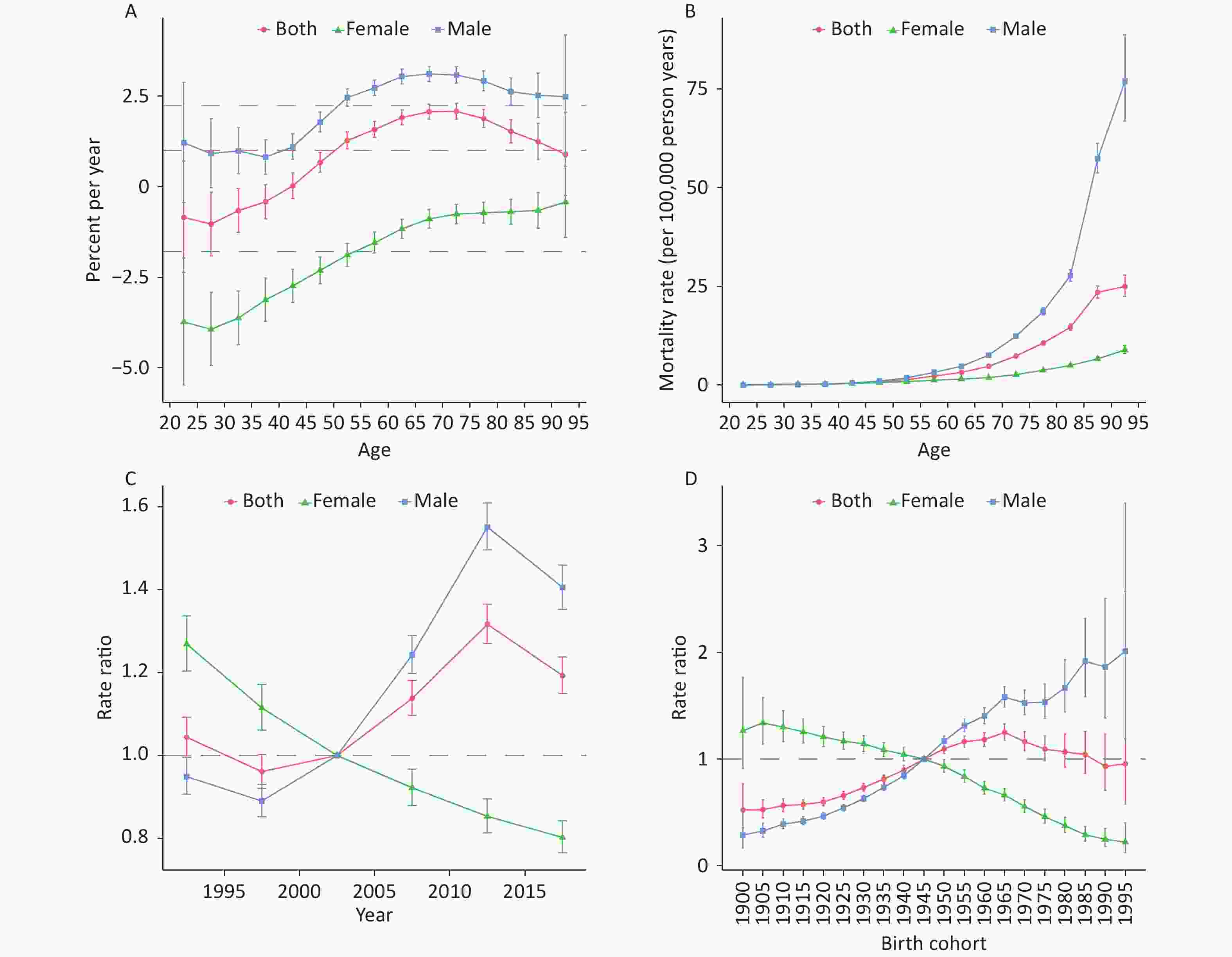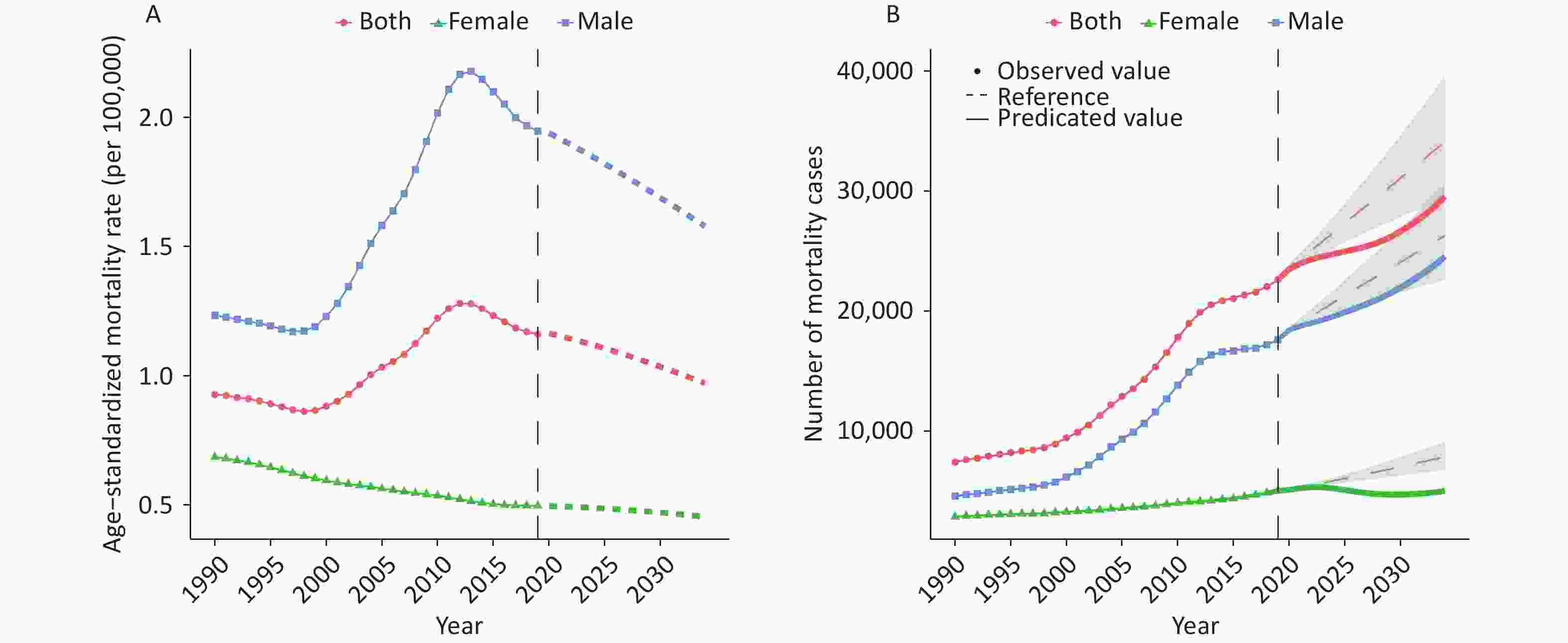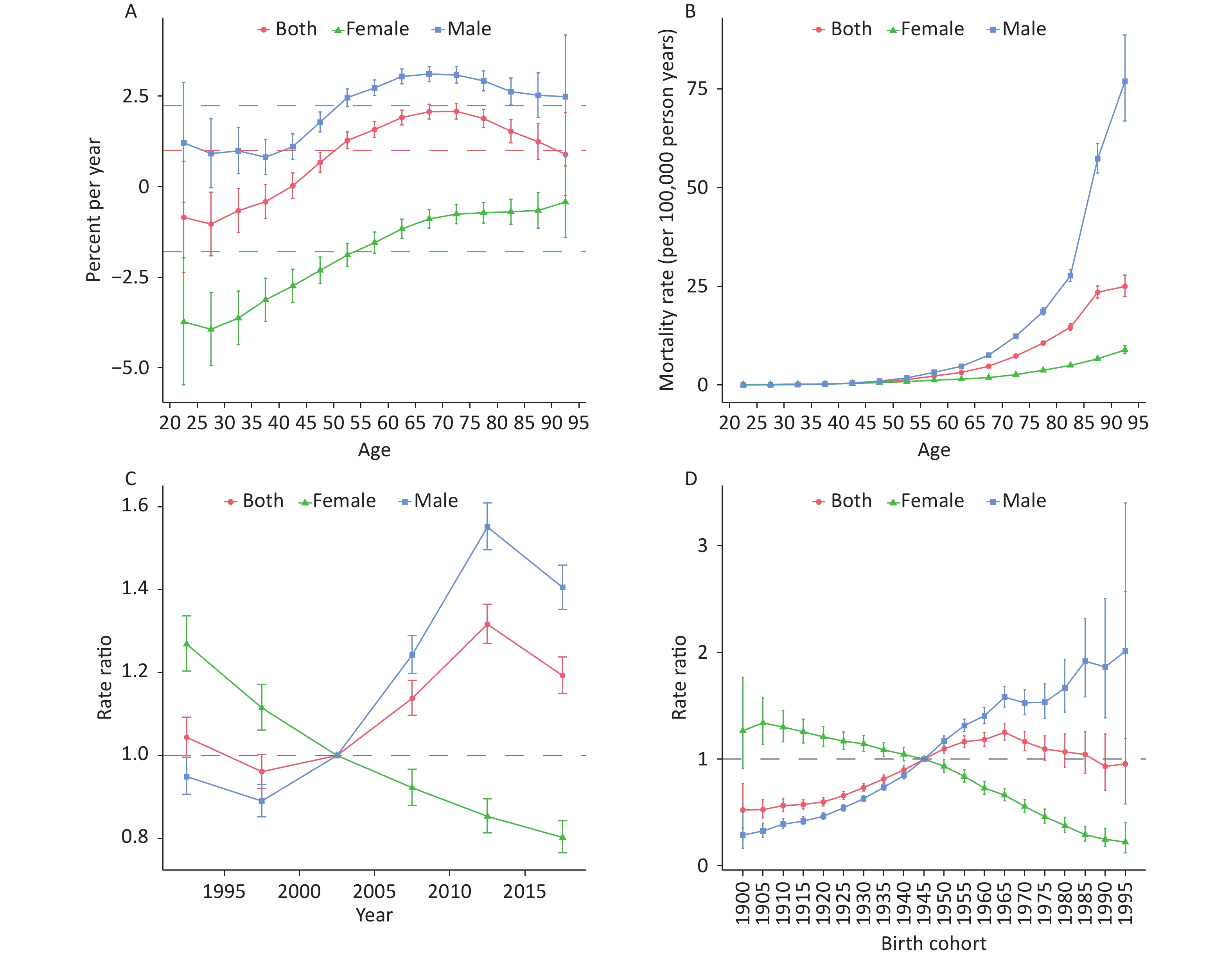-
Oral cancer is the most common malignant tumor of the head and neck. It is characterized by high rates of recurrence and distant metastasis and usually has a poor prognosis. Despite advances in cancer diagnosis and treatment, the overall 5-year survival rate for oral cancer remains within 40%–50%[1].
Recently, there has been a rapid increase in the incidence and mortality rates of oral cancer, resulting in a significant global burden. Oral cancer is often overlooked in the formulation of governmental public health policies despite being an important component of global oral health issues. The incidence and mortality rates of oral cancer are two to three times higher in developing than in developed countries or regions[2]. The annual increase in the mortality and incidence rates of oral cancer in China have exceeded the global average from 1990 to 2017, placing a huge disease burden on Chinese citizens[3]. This study used the latest data from the 2019 Global Burden of Disease (GBD 2019) study to objectively analyze the trends of oral cancer mortality in China within the framework of an age-period-cohort (APC) model and explain the forces driving these trends. We also forecasted mortality trends in China over the next 15 years. These findings may inform pertinent health strategies for disease prevention and contribute to the realization of the goals of the “Healthy China 2030” initiative in the future.
The main data source for this study was the GBD 2019 study that estimated the burden of 359 diseases and injuries and 84 risk factors in 204 countries (regions) from 1990 to 2019. The age-standardized mortality rate (ASMR) was determined using the GBD 2019 global age-standard population. The annual percent change and 95% confidence interval (CI) of the birth cohort mortality rate were calculated using a joinpoint regression program, and the mortality trend for oral cancer was analyzed. The level of significance was set at a P value less than 0.05.
We used the APC model to independently assess the effects of age, period, and cohort on disease mortality rates. In the APC analysis, oral mortality and population data were divided into consecutive 5-year periods from 1990 to 2019 and 5-year age intervals from 20 years to 95 years. The main estimable functions in our APC analysis were as follows: net drift, which indicates the overall annual percentage change adjusted using the age curve; local drift, which indicates the annual percentage change for each age group; the longitudinal age curve, which represents the trend of age-related disease changes (the age effect); and the period (cohort) relative risks (RRs), which refer to the ratios of age-specific rates in each period (or cohort) relative to the reference period, which represents the effect of the period (cohort). These estimable functions were assessed using the Wald chi-square test. All statistical tests were two-tailed. Statistical analyses were performed using the R software (version 4.2.0, R Core Team) developed by the National Cancer Institute in the United States.
We used a Bayesian APC (BAPC) model to predict the risk of death from oral cancer over the next 15 years. A second-order random walk model was used in smoothing the priors of age, period, and cohort effects to predict a posteriori mortality in the BAPC model. Our method incorporated the integrated nested Laplace approximation (INLA), which prevented the mixing and convergence problems caused by Markov Chain Monte Carlo sampling, resulting in data that were more stable and reliable[4]. Data from the 2019 revision of the United Nations World Population Prospects and were used to estimate the population of China in 2020 and beyond. The BAPC (version 0.036) and INLA (version 22.05.07) packages of the R software were used for statistical prediction.
The effects of age, study period, and cohort on oral cancer mortality were evaluated using the APC model (Figure 1). Net drift, which represents the overall annual percentage change across the study period (Figure 1A), was estimated to be 1% (95% CI: 0.84% to 1.16%) per year, 2.22% (95% CI: 2.04% to 2.40%) for males and –1.80% (95% CI: 1.99% to 1.60%) for females, indicating an improvement in the reduction of oral cancer mortality among females. Local drift represents the annual percentage change in oral cancer mortality rate for each age group from 20–24 years to 90–94 years (Figure 1A). In the elderly population (aged > 60 years), the local drift values for mortality were relatively large for both males and females.

Figure 1. Parameters estimated by age-period-cohort modeling for the mortality rates of oral cancer by sex in China from 1990 to 2019. The line segments represent the 95% confidence intervals. (A) Net drift values (horizontal lines) and local drift values (curves). (B) Longitudinal age curves adjusted for period effects. (C) Period rate ratios relative to the refence period of 2000–2004. (D) Cohort rate ratios relative to the reference cohort of 1940–1944.
Within the same birth cohort, the mortality rate of oral cancer increased with advancing age, with the fastest increase observed in the elderly population aged ≥ 65 years (Figure 1B). The longitudinal age curves exhibited an exponential distribution. The relationship between age and mortality can be expressed as = 0.037 × e0.059×age (R-squared = 0.999) and mortality rate can be expressed as = 0.016 × e0.092×age (R-squared = 0.990) for males and females, where “age” refers to the median age of each age interval. The results indicated that the RRs for oral cancer mortality at each life stage from ages 20–24 years to 90–94 years were 1.343 for males and 1.584 for females compared to those at previous life stages.
Diabetes among the elderly population in China may have contributed to the rapid increase in the mortality rate of patients aged ≥ 65 years with oral cancer. China has one of the largest populations of patients with diabetes, and the prevalence rate in the elderly population aged over 65 years is close to 30%. A meta-analysis has shown that diabetes can significantly increase the risk of mortality of oral cancer to 2.09 times higher than that of the general population[5]. In addition, the aging of the Chinese population has increased rapidly from 2010 to 2020, with the proportion of the population aged > 60 years increasing from 13.26% to 18.70%. These factors may have contributed to the age trend of oral cancer mortality in China[6].
The period (cohort) RRs represents the ratios of age-specific rates in each period (cohort) relative to the reference period (cohort). After adjusting according to age and birth cohort, we found that period RRs for males initially increased and then decreased, with the RR peaking in 2010–2014 (1.55, 95% CI: 1.50 to 1.61) and then decreasing in 2015–2019; whereas, for females, there was a gradual reduction in the RR throughout the study period (Figure 1C).
Period effect refers to the risk of incidence or mortality of an age group caused by changes in natural conditions or the social environment within a specific period. Our study suggested that the risk of oral cancer mortality in females gradually decreases over time. In contemporary China, because of rapid development, economic transformation, and urbanization, the lifestyles of people have undergone great changes. Changes in the environment and living conditions have led to improvements in living standards, which may be a protective factor for females compared to males as this may lead to more opportunities to consume fruits. Previous studies have demonstrated that increasing the intake of fresh fruits may reduce the risk of oral cancer[7]. Although the mechanism by which fruit prevents cancer is not clear, the antioxidant vitamins C and E may play a role in this regard[7]. The risk of male mortality showed a notable decreasing trend from 2010–2014 to 2015–2019, possibly because China implemented a series of measures to control the smoking rate. According to data from the Global Adult Tobacco Survey, the smoking rate in the Chinese population aged > 15 years dropped from 30.30% in 2010 to 28.69% in 2018[8]. A decline in smoking (a known risk factor for oral cancer) may account for the decline in mortality risk, to some extent.
We also found that the cohort RRs showed different patterns between the sexes. In the continuous birth cohort, the RR of mortality gradually increased in males and decreased in females (Figure 1D). The RR of mortality also moderately increased in men born after 1955 (Supplementary Figure S1, available in www.besjournal.com). In addition, the results of the Wald tests indicated that the period and cohort RRs were statistically significant (P < 0.01), as were the net drift and local drift values (P < 0.01; Table 1).
Table 1. Statistical parameters for overall and age-specific annual percent changes in age-period-cohort-models
Sex Net drift values = 0 All local drift values = net drift value All cohort RR = 1 All period RR = 1 Wald tests P value Wald tests P value Wald tests P value Wald tests P value Both 148.54 < 0.01 153.39 < 0.01 677.99 < 0.01 339.34 < 0.01 Male 625.34 < 0.01 123.45 < 0.01 1596.94 < 0.01 978.56 < 0.01 Female 326.19 < 0.01 105.53 < 0.01 361.11 < 0.01 326.97 < 0.01 
Figure S1. Cohort rates (estimated percentage change per year by birth cohort) of oral cancer in China, stratified by sex. *Indicates that the Annual Percent Change (APC) is significantly different from zero at the alpha = 0.05 level.
Our study found that, in China, males born in later cohorts have a higher risk of mortality, whereas women born in later cohorts have a lower risk of mortality. This sex-related difference may be attributed to the fact that young males are considered the backbone of the family and society and have potentially greater exposure to occupational carcinogens. Some studies have reported that occupational exposure to asbestos, chlorinated solvents, oxygenated solvents, welding, and other environmental factors increases the risk of oral cancer[9]. In addition, the 30-year lag in the effects of chewing betel nuts may explain the slower rise in mortality risk among young males (particularly those born after 1955). A previous study has identified an extremely high correlation coefficient between the cohort effects of oral cancer incidence in men and the average consumption of betel nuts with a lag time of 30 years[10]. Controlling modifiable risk factors may be an effective measure to reduce the disease burden in men. Therefore, in view of the low survival rate of patients with oral cancer, policy-makers should take significant actions to identify risk factors and reduce high-risk exposure.
Using the BAPC model, we predicted the ASMR and number of deaths in the next 15 years (Figure 2). Over the next 15 years, the ASMR of oral cancer will show a downward trend, whereas the number of deaths will continue to increase from 2020 to 2034 (Figure 2). This inconsistency reflects that population aging is an important driver of the burden of oral cancer deaths. Although our predicted results were somewhat lower than the optimistic reference with a 1% annual rate of decline, the number of deaths will increase from 22,641 in 2019 to 30,965 in 2034 (Figure 2B).

Figure 2. The prediction of age-standardized mortality rate (ASMR) and number of deaths in China from 2020 to 2034. (A) Projected ASMR. (B) Projected number of deaths. The solid lines present the projected values. The dashes with shading represent the reference calculated using the observed values in 2019.
In summary, the RR of mortality in females showed generally improving trends over time and in successively younger birth cohorts. The cohort effect, as a key factor, greatly affected the trends of oral cancer deaths in males. This indicates that risk factors for oral cancer in China are not well-controlled. Another important area for improvement is aging population of China, which will continue to drive the mortality burden of oral cancer over the next 15 years. Therefore, it is extremely important to control the risk factors and implement healthy aging policies and measures for the prevention and treatment of oral cancer in China.
doi: 10.3967/bes2023.068
Trends of Oral Cancer Mortality in China from 1990 to 2019 and a 15-Year Predictive Analysis Based on a Bayesian Age-Period-Cohort Model
-
&These authors contributed equally to this work.
注释: -
Figure 1. Parameters estimated by age-period-cohort modeling for the mortality rates of oral cancer by sex in China from 1990 to 2019. The line segments represent the 95% confidence intervals. (A) Net drift values (horizontal lines) and local drift values (curves). (B) Longitudinal age curves adjusted for period effects. (C) Period rate ratios relative to the refence period of 2000–2004. (D) Cohort rate ratios relative to the reference cohort of 1940–1944.
Figure 2. The prediction of age-standardized mortality rate (ASMR) and number of deaths in China from 2020 to 2034. (A) Projected ASMR. (B) Projected number of deaths. The solid lines present the projected values. The dashes with shading represent the reference calculated using the observed values in 2019.
Table 1. Statistical parameters for overall and age-specific annual percent changes in age-period-cohort-models
Sex Net drift values = 0 All local drift values = net drift value All cohort RR = 1 All period RR = 1 Wald tests P value Wald tests P value Wald tests P value Wald tests P value Both 148.54 < 0.01 153.39 < 0.01 677.99 < 0.01 339.34 < 0.01 Male 625.34 < 0.01 123.45 < 0.01 1596.94 < 0.01 978.56 < 0.01 Female 326.19 < 0.01 105.53 < 0.01 361.11 < 0.01 326.97 < 0.01 -
[1] Zeng HM, Chen WQ, Zheng RS, et al. Changing cancer survival in China during 2003-15: a pooled analysis of 17 population-based cancer registries. Lancet Glob Health, 2018; 6, e555−67. doi: 10.1016/S2214-109X(18)30127-X [2] Zhang LW, Li J, Cong X, et al. Incidence and mortality trends in oral and oropharyngeal cancers in China, 2005-2013. Cancer Epidemiol, 2018; 57, 120−6. doi: 10.1016/j.canep.2018.10.014 [3] Ren ZH, Hu CY, He HR, et al. Global and regional burdens of oral cancer from 1990 to 2017: Results from the global burden of disease study. Cancer Commun (Lond), 2020; 40, 81−92. doi: 10.1002/cac2.12009 [4] Schmid VJ, Held L. Bayesian age-period-cohort modeling and prediction -BAMP. J Statist Software, 2007; 21, 1−15. [5] Li YZ, Teng D, Shi XG, et al. Prevalence of diabetes recorded in mainland China using 2018 diagnostic criteria from the American Diabetes Association: national cross sectional study. BMJ, 2020; 369, m997. [6] Tu WJ, Zeng XW, Liu Q. Aging tsunami coming: the main finding from China's seventh national population census. Ag Clin Exp Res, 2022; 34, 1159−63. doi: 10.1007/s40520-021-02017-4 [7] Gupta B, Bray F, Kumar N, et al. Associations between oral hygiene habits, diet, tobacco and alcohol and risk of oral cancer: A case-control study from India. Cancer Epidemiol, 2017; 51, 7−14. doi: 10.1016/j.canep.2017.09.003 [8] Zhang GT, Zhan JJ, Fu HQ. Trends in smoking prevalence and Intensity between 2010 and 2018: implications for tobacco control in China. Int J Environ Res Public Health, 2022; 19, 670. doi: 10.3390/ijerph19020670 [9] Clin B, Gramond C, Thaon I, et al. Head and neck cancer and asbestos exposure. Occup Environ Med, 2022; 79, 690−6. doi: 10.1136/oemed-2021-108047 [10] Su SY, Chen WT, Chiang CJ, et al. Oral cancer incidence rates from 1997 to 2016 among men in Taiwan: Association between birth cohort trends and betel nut consumption. Oral Oncol, 2020; 107, 104798. doi: 10.1016/j.oraloncology.2020.104798 -
 22394+Supplementary Materials.pdf
22394+Supplementary Materials.pdf

-




 下载:
下载:






 Quick Links
Quick Links